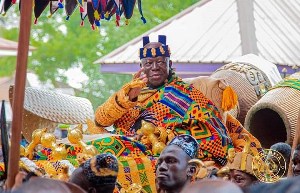Opinions of Thursday, 4 February 2016
Columnist: Sawyerr, Ade
E. A. Ammah’s ethnographic vision by Marion Kilson
In 2016 Sub-Saharan Publishers will publish Kings, Priests, & Kinsmen: Essays on Ga Culture and Society by E. A. Ammah, edited by Marion Kilson. This essay is based on Marion Kilson's introduction to the volume.
AtaaAmmah
E. A. Ammah (1900-1980) gained renown as an authority on Ga culture and society beginning in the 1930s. He was the first Ga person to speak on the radio aboutH?m?w? and he published a number of essays in the Ghanaian press over the years. As the head of one of three Ga royal houses, he was an active participant in the proceedings of the Ga Royal Council for many years. As a devout Anglican, he sought to demonstrate the correspondences between Ga religion and Christianity as well as other world religions including Judaism, Hinduism, Buddhism, and Islam.[1] His interests in Ga cultural studies were wide-ranging including social organization, political history, life transition ceremonies, and religion.
A close reading of E. A. Ammah's essays reveals that his ethnographic vision had two principal components. The first was ensuring the accurate recording and interpretation of Ga institutions and the second was positioning Ga culture within the context of other world cultures. The first was a concern from the time that he began researching traditional Ga religion in the 1930s and the second seems to have emerged in his writing in the early 1960s.
Ga-focused Ethnographic Vision
In pursuit of ethnographic accuracy, E. A. Ammah not only took meticulous interview notes like those enshrined in his 1937 field diary but took to task others who did not record the ethnographic facts as he understood them. He wrote a blistering 1941 review essay of M. J. Field's book, Social Organization of the Ga People. In it he ridiculed the first major British ethnographer of Ga society for her misinterpretation of the Ga political system. His critique begins: "Some of the disclosures are as startling as they are vexatious. The theory that she so remarkably attempts to develop is that (1) the Gas are not one people either in origin or organization; (2) that each town is an independent republic with its own territory and its own unique set of customs; (3) that there has never been any political association between the towns and they have never had a paramount chief... (4) that the stool is not a monarch's throne...and (5) that the Government of every town is a gerontocracy." With this opening salvo, Ammah proceeds to challenge each of these "vexatious" formulations pointing out his perception of Field's errors of fact and interpretation. Mr. Ammah was not the only one who objected to Field's characterization of the Ga polity, for two months later a newspaper editorial stated "Readers will remember that following the release of the book for sale critical reviews and protests began to appear, particularly from the Ga State Council in the press. A representative of the same Council submitted objections to the Eastern Provincial Council of Chiefs...This was accompanied by the slaughter of sheep to remove...the stigma of insult brought on the Stools and the tribe by the statements published and asked that representation be made with a view to the withdrawal of the book." Despite the barrage of Ga-inspired criticism, the book lives on!
E. A. Ammah's own recording of Ga ethnography covered a broad institutional range. He wrote about social organization in general, beliefs in ancestors, inheritance customs, and forms of marriage as well as land tenure procedures. He wrote about the Ga Constitution and political structure, he wrote about royal history, and he wrote a poetic lament about the removal of the old Ga town of Tema to make way for the modern port of Tema in 1959. He wrote about Ga life transition ceremonies—the passage from thing to kinsman of a week old infant at its naming ceremony, puberty rituals, and funeral customs. He wrote about Ga religion and world view, about religious songs, about water in ritual, and about the compatibility of traditional Ga social mores with Christian practices. In all of these ethnographic writings he envisoned that he was creating an accurate record of Ga cultural mores.
Among these Ga-focused ethnographic writings, several pieces stand out as exceptional contributions to Ga studies. In 1965 E. A. Ammah wrote a paper entitled "Sixty Years of Ga Politics" which represents a unique insider's perspective on Ga royal politics. Chronicling the history of Ga kingship especially from 1900 on, the essay essentially recounts a story of multiple enstoolments and destoolments within a colonial framework of changing political and economic opportunities. As head of one of three Ga royal houses, E. A. Ammah was an active participant in electing and enstooling a new king in 1964. As a stickler for tradition, he was concerned by the political and ceremonial errors that he perceived surrounding the enstoolment of the new Ga king. Rival candidates for the kingship, plotting electors, multiple votes, absent electors at voting time marred the selection process. Then the midnight enstoolment of the king was rife with ceremonial errors—too many people in the stool room, some who should have been inside the room were not, while others who should not have been inside were; the king was not given all the appropriate insignia of office during the ceremony; oaths of allegiance between the king and individual chiefs and elders did not follow the prescribed order. So concerned was E. A. Ammah by these departures from established custom that he concludes his essay by writing, "The events and circumstances surrounding the election and enstoolment of Nii Taki Amugi II suggest that the exalted position of the Ga stool became a toy in the hands of the Ga people, an unprecedented situation in the history of the Ga royal family." When this essay was posted on The Ade Sawyerr Blog in 2014, readers commented on how Ammah's analysis helped them to understand the stool disputes during the past decade following King Taki Amugi II's death after a forty year reign.
To the study of Ga traditional religion, I think that E. A. Ammah made two singular contributions—one a methodological innovation, the other a remarkable document.
His methodological innovation was to demonstrate the richness of traditional Ga religious songs for understanding Ga religious thought. Because the language of these songs is linguistically complex—often combining Ga and other African languages within a single hymn and even a single line, the meaning is not always readily intelligible. Previous scholars like M. J. Field had written that "the songs were full of life" but "gibberish." E. A. Ammah in his writings has shown that the songs are not gibberish, that deciphering them can be difficult, but that the texts reveal much about the world view and society of Ga people.
The remarkable document that E. A. Ammah created was a "Ga Calendar" in which he records the annual cycles of religious observances for all the major gods and chiefly stools in each of the nine Ga towns strung along the southeastern Ghanaian coast from Accra to Ningo—some 217 ceremonies extending from twenty weeks in Accra to three weeks in Ningo. The calendar is more than simply a listing of ceremonies in relation to one another, for it incorporates an explanation of the calculation of the lunar-based ritual year which may vary from 357 days to 371 days, descriptions of some rituals, and recordings of a few religious songs. This amazingly complex yet coherent document is an invaluable resource for anyone interested in Ga religious rituals as practiced in the mid-20thcentury.
Comparative Ethnographic Vision
Important as E. A. Ammah's essays on Ga polity, kinship structures, life transition ceremonies, and religion are, the truly remarkable essays are his comparative ethnographic essays in which he examines correspondences between Ga thought and that of other cultural traditions. The most impressive of these comparative essays is "Ghanaian Philosophy" which was published in six successive monthly issues of The Ghanaian beginning in October 1961.[2] Although E. A. Ammah titles his essay "Ghanaian Philosophy," his exposition is an exploration of Ga philosophy as revealed primarily in Ga religious hymns. In comparing Ga thought with other traditions, he draws upon a wide variety of sources including the Bible, articles in The Hibbert Journal, classic anthropological monographs on African and Latin American societies, various encyclopedias, as well as Islamic, Indian, Judaic, and Buddhist teachings.[3] The essay begins "Ga thought unlike Greek, but like Hindu is three in one, and one in three, namely philosophy, religion and science. It must be remarked in passing that Indian 'religion and philosophy are one', and that, 'For India, then, there can be no real conflict between science and religion, between religion and thought.' This is exactly the content of Ga thought; the sole difference is that, India stresses pantheism, while Ga upholds theism, God's transcendence or revelation." Ammah identifies three schools of Ga thought—the God's School which celebrates the primacy of a Supreme Being in the universe, the Wisdom School which is concerned with theology and religious practices, and the Sceptic School which emphasizes the philosophy of doubting. In developing the characteristics of these philosophical schools, Ammah discusses correspondences between Ga beliefs and practices and other traditions including parallels between Ga and Christian trinities, between Ga concepts of deities and the ministry of angels in the Roman Catholic church and in Muslim theology, parallels between ancient Greek thought and ideas expressed in Ga circumcision and naming rituals, the centrality of the concept of God for Immanuel Kant and for Ga thinkers, and so on. This paper is truly a tour de force; moreover, it is remarkable that a man whose formal education ended with Standard VII should have had the intellectual curiosity and acumen to explore Christianity, Islam, Hinduism, Judaism, and Marxism in relation to Ga concepts and practices.
Roots of E. A. Ammah's Ethnographic Vision
What are the roots of E. A. Ammah's ethnographic vision? Why was it so important to him to insist on the accurate recording of his own culture that he was willing to sacrifice his career advancement for it? What did he hope to achieve by showing correspondences between Ga philosophy enshrined in religious songs and those of major world cultures? Although I can only conjecture the roots of his ethnographic vision, I think his pride in his cultural heritage, his awareness that Ga culture was less studied and less well known than other Ghanaian cultures such as those of the Ashanti and Ewe, and his wish to demonstrate the sophistication of African thought contributed to his years of research, reflection, and writing. The forthcoming book of E. A. Ammah's extant papers will serve as a tribute to the vision of a man who once proclaimed:
Why go to ancient Greece,
And other far off lands,
In search of golden fleece?
'Tis here, where Ghana stands.[4]
[1] E. A. Ammah remembered being a fisherman before he went to school. He completed Standard VII and then began his career as a clerk in the national railway department stationed in Accra. He said that he refused to accept positions outside Accra lest he lose opportunities to study his culture. He said that throughout his life he spent any spare money that he had buying books.
[2] This essay was published on The Ade Sawyerr Blog in February 2014.
[3]The Hibbert Journal was a liberal Christian periodical published in Britain from 1902-1968.
[4] E. A. Ammah, "Ghanaian Philosophy," The Ghanaian (October 1961), p.1.
--
Best Regards
Ade
http://adesawyerr.wordpress.com
http://twitter.com/adesawyerr
Entertainment











